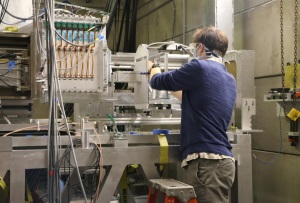by
John R. Fischer, Senior Reporter | November 10, 2020

Mevion's s250i proton accelerator has shown success in being able to deliver Flash therapy in preclinical trials
Mevion Medical Systems has shown progress in utilizing the FLASH effect in a preclinical trial involving its S250i proton accelerator, according to findings presented at the American Society for Radiation Oncology (ASTRO) Annual Meeting.
The company's research showed a clear signal in the survival curves, where the FLASH effect was delivered at the Bragg peak. The Bragg peak plots the energy loss of ionizing radiation as it travels through matter and occurs immediately before proton, Alpha-rays and other ion ray particles come to rest.
"The unique design of Mevion's energy selection system allows, for the first time, the use the Bragg peak of the proton in the FLASH research," Skip Rosenthal, senior vice president of clinical relations, told HCB News. "This opens the door for combining the protection of normal tissues within a FLASH field with the protection of rapid dose fall-off beyond a target. Demonstrating successful FLASH research on the most compact and affordable proton system will open research to a greater number of academic centers than otherwise possible."



Ad Statistics
Times Displayed: 2046
Times Visited: 23 Keep biomedical devices ready to go, so care teams can be ready to care for patients. GE HealthCare’s ReadySee™ helps overcome frustrations due to lack of network and device visibility, manual troubleshooting, and downtime.
By sparing normal tissue from Flash irradiation with pulsed proton beams rather than electron beams, the research presents the opportunity to investigate how the FLASH "effect" scales with short pulses of ultra-high instantaneous dose rates at clinically significant depths, according to Rosenthal.
The researchers conducted the trial on a group of healthy mice, with the aim being to increase their survivability when delivering doses at FLASH rates, which are lethal when delivered at conventional dose rates. Mevion’s S250i proton accelerator is equipped for such a task due to its Direct Beam Delivery (DBD) system architecture, which has a beam line where transmission efficiency does not drop below 70%. This enables a Bragg peak FLASH effect at ultra-high dose rates.
Mevion plans to implement protocols that will more specifically define the thresholds of dose rate and dose for Flash effects in various animal models. It is also building relationships with NCI-designated cancer hospitals to leverage expertise in the biology and biochemistry of FLASH.
"We expect that studies will first be conducted at the Mevion factory, and soon at various centers equipped with a FLASH mode on their clinical machines," said Rosenthal.
Preclinical research on the effects of FLASH therapy has helped the practice progress in its evaluation, with FDA
granting an investigational device exemption to Varian last month to conduct the first ever clinical trial for FLASH therapy. The trial will utilize Varian’s ProBeam proton particle accelerator modified with a specialized module with FLASH capabilities to treat 10 patients with bone metastases.
FLASH Therapy is under preclinical research and not yet available for commercial sale or clinical use.

